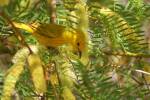Attract hummingbirds to bring excitement to your garden
Tiny, quick, and agile hummingbirds are loved by birdwatchers young and old. Their large appetites, their territorial nature at feeders, and their helicopter-like hovering fascinate many, as well as their ability to travel thousands of miles with such little wings. The hummingbird migration, where they fly south in the fall and return back north in the spring, is an event that is highly regarded as one of nature's most amazing journeys.
There are about 332 species within the hummingbird family. Generally weighing less than an ounce and measuring about 3 inches in length, the average hummingbird is a favorite of birding enthusiasts. Their robust coloring, tiny stature and entertaining feeding activity make them a welcome sight. Birdfeeders.com hosts a robust hummingbird species library where you can check out the most common types that you may see in your backyard.
One of the most amazing things about the hummingbird is its migration. The twice-annual journey takes the birds to Mexico and South America in late fall; they return north between the months of March and June. This journey has been done for thousands of years and hummingbirds have perfected the art of travel. The hummingbird knows it is time for the fall migration when the number of daylight hours shrinks to a certain point. At this time a chemical reaction in the bird's brain cues it to head south.
Not all hummingbirds in the United States migrate, says Ross Hawkins, director of The Hummingbird Society. The Rufous hummingbird claims the longest migratory distance and has been found to travel back and forth between Anchorage, Ala. and Southern Mexico - a journey of about 3,000 miles each way. Ruby-throated hummingbirds also migrate and are the type of hummingbird that we are most familiar with. Rubies can migrate as far south as Panama and as far north as Nova Scotia.
Many birders enjoy sharing their first hummingbird sightings with others. Online migration maps exist where individuals can record seeing hummingbirds in their area. Looking at this map every few days allows you to see how close the hummingbirds are to making their way to your hometown. Maps like the one offered by Perky-Pet are interactive and allow you to participate in tracking migration. Visit the migration map to start watching.
Like a car traveling a long distance, these tiny birds need fuel to get from one place to the next. The diet of this traveler includes small insects and nectar from hummingbird feeders and flowers. Prior to migration, most hummingbirds add at least 30 percent of their body weight to their fat reserves in order to make it to their destination. Ruby throated hummingbirds, however, add 100 percent of their body weight to their fat reserves, doubling their body weight before their journey. Hummingbirds rely on insects, flowers and hummingbird feeders to recharge themselves along their journey.
Hummingbird feeders offer a supplemental source of nectar to give hummingbirds energy for their travels. Hang hummingbird feeders in your yard in support of the migration and create feeding stations. Because hummingbirds are territorial of feeders, placing more than one feeder on your property will allow them to comfortably fill up without overcrowding and confronting fellow feathered friends. Stocking up on high quality and affordable hummingbird feeders will assure hummingbirds have enough to eat. Feeders should be cleaned at least once a week, sometimes more during the warmer summer months.
Whether your birding skills are novice or expert, the hummingbird migration is sure to fascinate you. Participate by learning more about this unique species, tracking their travels using the migration map and feeding the hungry birds as they travel to and from their summer vacation destination.























